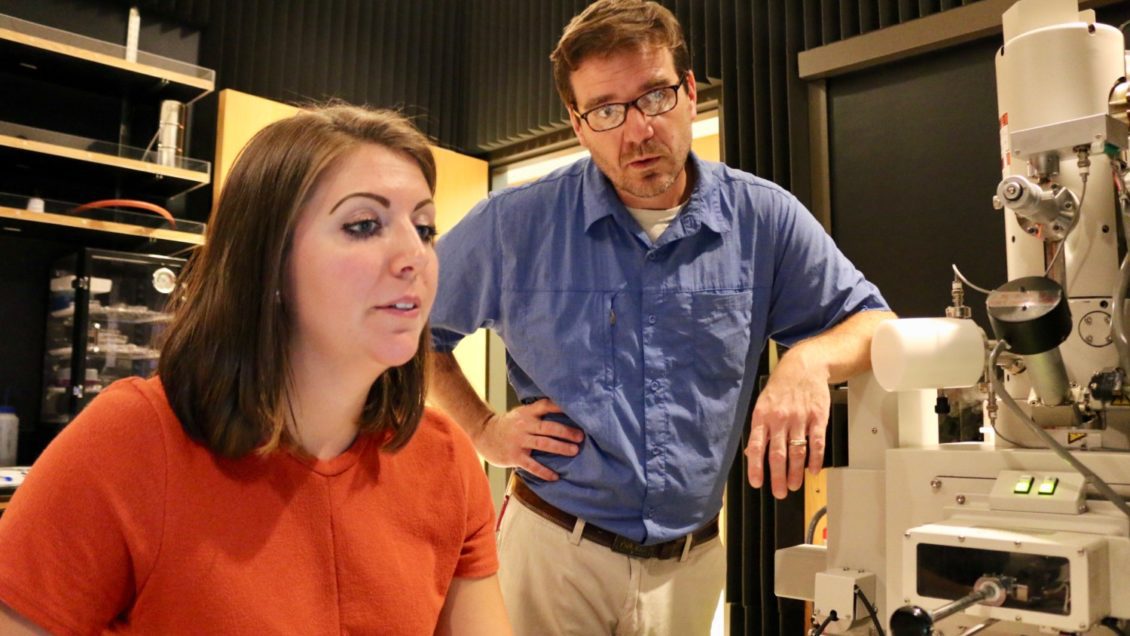
CLEMSON — A Clemson University Ph.D. student whose environmental research focuses on nuclear-site remediation has received the 2018-19 Hitachi High Technologies Electron Microscopy Fellowship and $20,000 to support her studies.
Fellowship recipient Kathryn Peruski also earns use of the university’s high-tech Electron Microscope Facility, which is stocked with Hitachi’s super-magnifying microscopes that allow materials to be analyzed at a nanoscale.
Using the microscopes, Peruski has captured the miniscule fragmenting of neptunium, a radioactive byproduct of nuclear power generation that is stored underground.
“This is the first time anyone has captured this image,” said Brian Powell, Peruski’s adviser and Fjeld professor in nuclear environmental engineering and science who has a joint faculty appointment at the Savannah River National Laboratory.
Through her research, Peruski hopes to better understand what causes neptunium to break so engineers can design effective storage methods for nuclear waste. She will analyze several neptunium samples exposed to environmental variables and document their changes over time.
Neptunium has a half-life – the time it takes for half of the material to decay – exceeding 2 million years. While environmental contamination from neptunium is highly unlikely now, scientists must have plans to safely handle nuclear waste well into the future, Peruski said.
“The biggest obstacle to the future of the nuclear industry is the safe storage of nuclear waste,” she said. “You don’t want to wait until this is a problem to solve it.”

Peruski said the Hitachi fellowship gives her freedom to explore numerous scientific questions she may not be able to pursue under other grant-funded projects.
“The Hitachi fellowship really gives me creative freedom,” she said.
Peruski, who completed her undergraduate degree at the University of Notre Dame, began her studies at Clemson in 2015 and hopes to earn a Ph.D. in environmental engineering and Earth sciences. She has co-authored numerous research publications since her arrival at Clemson and has earned several recognitions, including the U.S. Department of Energy Innovations in Nuclear Technology R&D Award, the R.C. Edwards Clemson University Graduate Recruiting Fellowship, the Clemson University College of Engineering Dean’s Scholarship and the Nuclear Regulatory Commission Graduate Fellowship.
Hitachi High Technologies America Inc. helped to establish the university’s Electron Microscope Facility in the mid-1990s. The Electron Microscope Facility has steadily grown with Hitachi’s support and is housed at the Advanced Materials Research Laboratory in Anderson, about 15 minutes from Clemson’s main campus.
“Our longstanding relationship with Hitachi has provided Clemson faculty and students with one of the nation’s premiere microscopy labs in which to learn and conduct research,” said Tanju Karanfil, Clemson vice president for research. “Additionally, this fellowship has helped us recruit and train highly talented students.”
Hitachi established the fellowship in 2014. Peruski is the fifth recipient. Hitachi High Technologies America President and CEO Craig Kerkove and Phil Bryson, vice president and general manager of the Nanotechnology Systems Division of Hitachi High Technologies America, presented Peruski her fellowship during a Sept. 28 ceremony at the Madren Conference Center.
“This fellowship is the culmination of our ongoing collaboration with the university,” Kerkove said. “It is made possible by a series of contributions from Hitachi High Technologies America and is now helping its fifth student perform cutting-edge research. Clemson’s world-class Advanced Materials Research Laboratory, with its eight Hitachi microscopes, serves as an example for other institutions to emulate.”

The Electron Microscope Facility, which houses some of the world’s most cutting-edge microscopes, has been hailed as a national model. Officials from Georgia Tech and Harvard University have visited campus to see it. The facility is used by researchers in many Clemson disciplines and offers a unique platform for educating students. The facility is also used by the private sector for product development in the state’s automotive, aerospace, medical, electronics, textile and energy industries, among others.
“Our partnership with Hitachi has created a truly unique facility in the Southeast, which has greatly benefitted not only research and education at Clemson, but also product development and innovation in the private sector that will fuel the South Carolina economy,” said Electron Microscope Facility director Laxmikant Saraf. “I greatly appreciate Hitachi’s support.”
Bryson said the facility is mutually beneficial to both Clemson and Hitachi.
“Clemson has a state-of-the-art facility of instruments to enable a wide range of research pursuits, and Hitachi is able to demonstrate to universities around the world how a successful core research lab can be operated,” he said.
Douglas Hirt, associate dean for research and graduate studies in the College of Engineering, Computing and Applied Sciences, said the Hitachi fellowships give some of Clemson’s highest-achieving students the freedom to set aside financial concerns to focus on their research.
“I thank Hitachi High Technologies America Inc. for its continued support, and I congratulate Kathryn on receiving this year’s fellowship,” he said. “It is a well-deserved honor and a testament to the high quality of research she is doing, enabled by the Hitachi microscopes in Clemson’s world-class Electron Microscopy Lab.”
Get in touch and we will connect you with the author or another expert.
Or email us at news@clemson.edu

